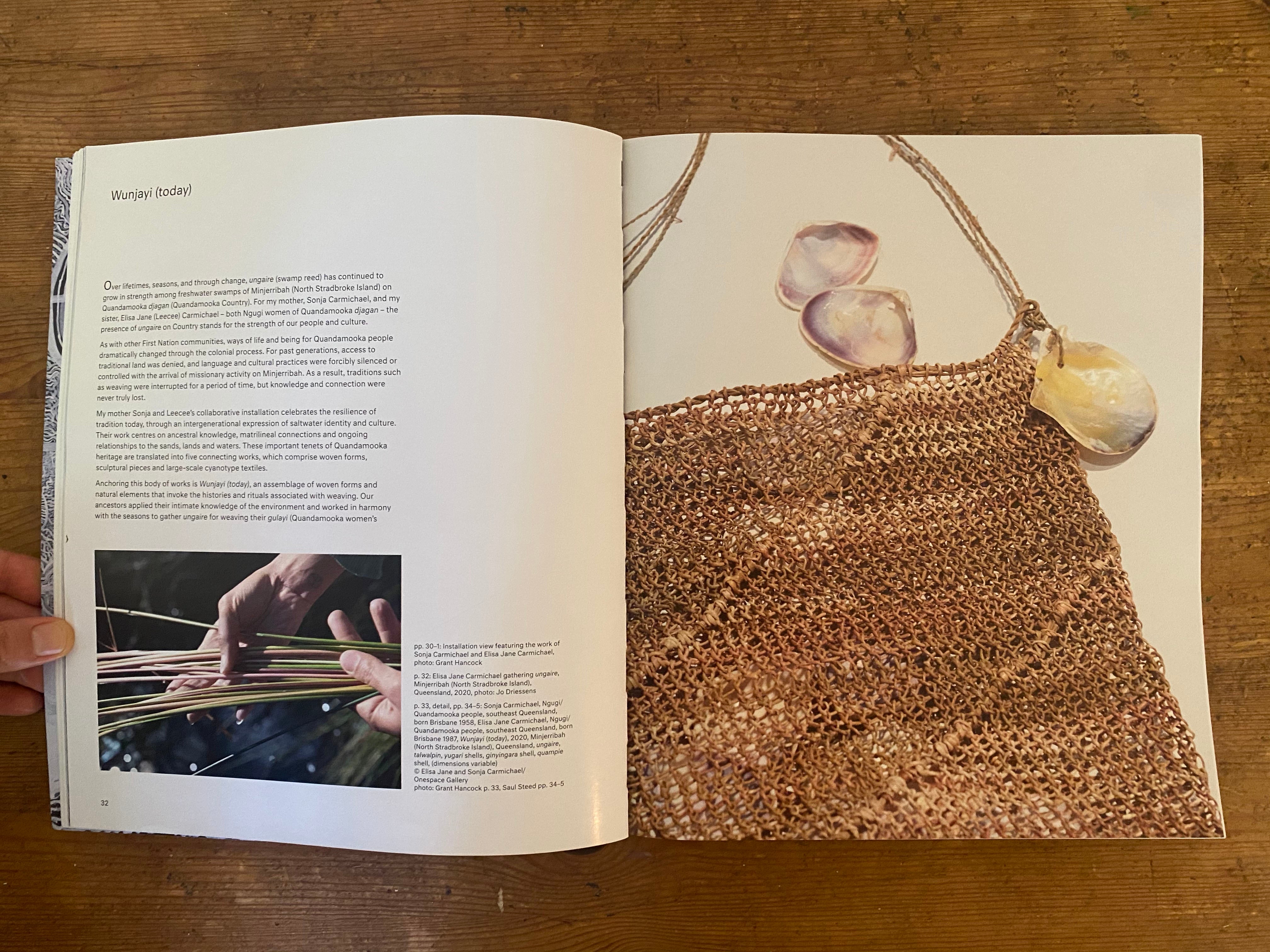Freja Carmichael is a Ngugi woman and curator belonging to the Quandamooka people of Mulgumpin (Moreton Island) and Minjerribah (North Stradbroke Island). Dedicated to cross-cultural sharing and sensitive curatorial practices, Freja’s projects foreground First Nations autonomy, presence and self-representation.
Freja has worked with First Nations people from around the world and has spent considerable time connecting with artists and collaborators, curating exhibitions and researching and writing.
Freja’s work embeds cultural and community-centred care into the arts sector. She’s an inspiration to many and we had the privilege of asking Freja more about her work; how it all began, impactful projects she’s worked on and what’s next for her...

Freja Carmichael
Tell us a little bit about who you are and what you do. I am Ngugi, one of three clan groups from beautiful Quandamooka country. Over the past ten years I have been working as a curator, arts worker, writer and researcher; collaborating with First Nations artists, Elders, communities and other curators in Australia and around the world. My past projects have focussed on cross-cultural sharing and promoting First Nations knowledges and artistic traditions including fibre work and weaving.
How did you start working in the arts sector? Many moons ago I was completing an internship at the Queensland Museum as part of my Bachelor of Creative Arts. It was here I first engaged with historical woven baskets and bags associated with Quandamooka, as well as ancestral cultural material from near and afar. I was so moved by the knowledges, experiences and histories embodied in these works. This opened up space for me to develop more sensitive ways of curating that embed cultural and community centred care.
How would you describe your curatorial process? I see curating as wearing many hats, and every project I have worked on has required a different role and approach. This approach is shaped by the storytellers, artists and communities I am working with, the context I am engaged in and respect to lands I am working on. The process in curating is very important to me, where the exhibition is an important outcome but so too is the opportunity to connect with artists and collaborators. Where possible I look for meaningful ways to develop an exhibition which can include community workshops, knowledge sharing and intergenerational collaborations. This approach started for me when I curated Gathering Strands, Redland Art Gallery in 2014. As part of this exhibition weaving workshops with Quandamooka women were held on Minjerribah to strengthen and regenerate local weaving practices.
“I see curating as wearing many hats, and every project I have worked on has required a different role and approach. This approach is shaped by the storytellers, artists and communities I am working with, the context I am engaged in and respect to lands I am working on.”

Freja contributed to the Becoming Our Future – a publication about Global Indigenous methodologies in curatorial practice. Edited by Dr. Julie Nagam, Carly Lane, Megan Tamati-Quennell and published by ARP Books.
Can you share with us a project that you really enjoyed working on? I have been very fortunate to be involved in many enriching projects across Australia and in North America and Aotearoa (New Zealand). From community events, festivals to exhibitions, outdoor installations, publications, gathering circles and exchange programs. All of these projects have helped me grow as a Quandamooka curator and gifted me with many special connections across country, lands and waters.
I recently worked in curatorial roles at Institute of Modern Art (IMA) and curated long water: fibre stories exhibition and publication. For this project I worked with my family and other Aboriginal and Torres Strait Islander women, community art centres, photographers, designers, writers, poets and IMA staff. I enjoyed working with many people from different backgrounds and bringing together their stories to embed the intersections between water, weaving, culture and country. Late last year, I spent a few months working with Maningrida Arts and Culture Centre in Arnhem Land on research and community engagement project for the Maningrida Collection of Aboriginal Art. It was such an honour to work closely with, and be mentored by senior artists and family members connected to the collection.

long water: fibre stories publication edited by Freja Carmichael and published by the Institute of Modern Art.
Another significant project for me has been collaborating with Indigenous curators; Sarah Biscarra Dilley (yak tityu tityu yak tiłhini Northern Chumash, Chicana), Léuli Eshrāghi (Sāmoa, Irānzamin, Guangdong), Tarah Hogue (Métis, Dutch) and Lana Lopesi (Sāmoa) to curate The Commute, IMA, and follow on iterations; Layover, Artspace Aotearoa and Transits and Returns, Vancouver Art Gallery. Through this traveling project First Nations artists and curators across the Great Ocean connected and shared between cultures, traditional knowledges and divergent geographies. These deep links formed between us all help to carve out the pathways ahead for strong cultural futures.
An earlier project that had huge impact on my sense of self was providing research assistance to Waanyi artist, Judy Watson on the names of places work. This artwork looked at massacres of Aboriginal people within Australia. I conducted research, read through various documents and books about this subject and contributed to an ongoing list of massacre sites which was then utilised in the digital map and the video of the names of places. I learnt further about the widespread massacre histories and of the events that directly affected Quandamooka people. For me this reinforces my strong lineage of survival.

Freja's words in Taranthi: Open Hands publication where she wrote about her mother and sister, Sonja and Leecee Carmichael’s collaborative work. Published by the Art Gallery of South Australia.
What do you value most about the arts? Aboriginal and Torres Strait Islander people are the first artists of this country. Across waters, coastlines, rivers, mountains, forests, bushlands and deserts are artistic traditions belonging to each country and nation. Art remains an important means of cultural strength; where language, knowledges and practices are expressed and cherished for the next generation. Art is also an important vehicle for sharing and interpreting today's lived experiences. There are so many powerful artists speaking out about past and present experiences, especially towards the ongoing destruction of the environment and histories that are yet to be fully acknowledged in this country.
“Aboriginal and Torres Strait Islander people are the first artists of this country. Across waters, coastlines, rivers, mountains, forests, bushlands and deserts are artistic traditions belonging to each country and nation.”
What’s next for you? Over the next few years, long water: fibre stories exhibition will visit many of the artists’ communities in the exhibition and I will be involved in this tour. I will be keeping busy with my ongoing work as an independent curator and writer. I will also start a very big project shortly, my PhD, that will culminate my work over the past decade on community centred curating and First Nations fibre practices.


